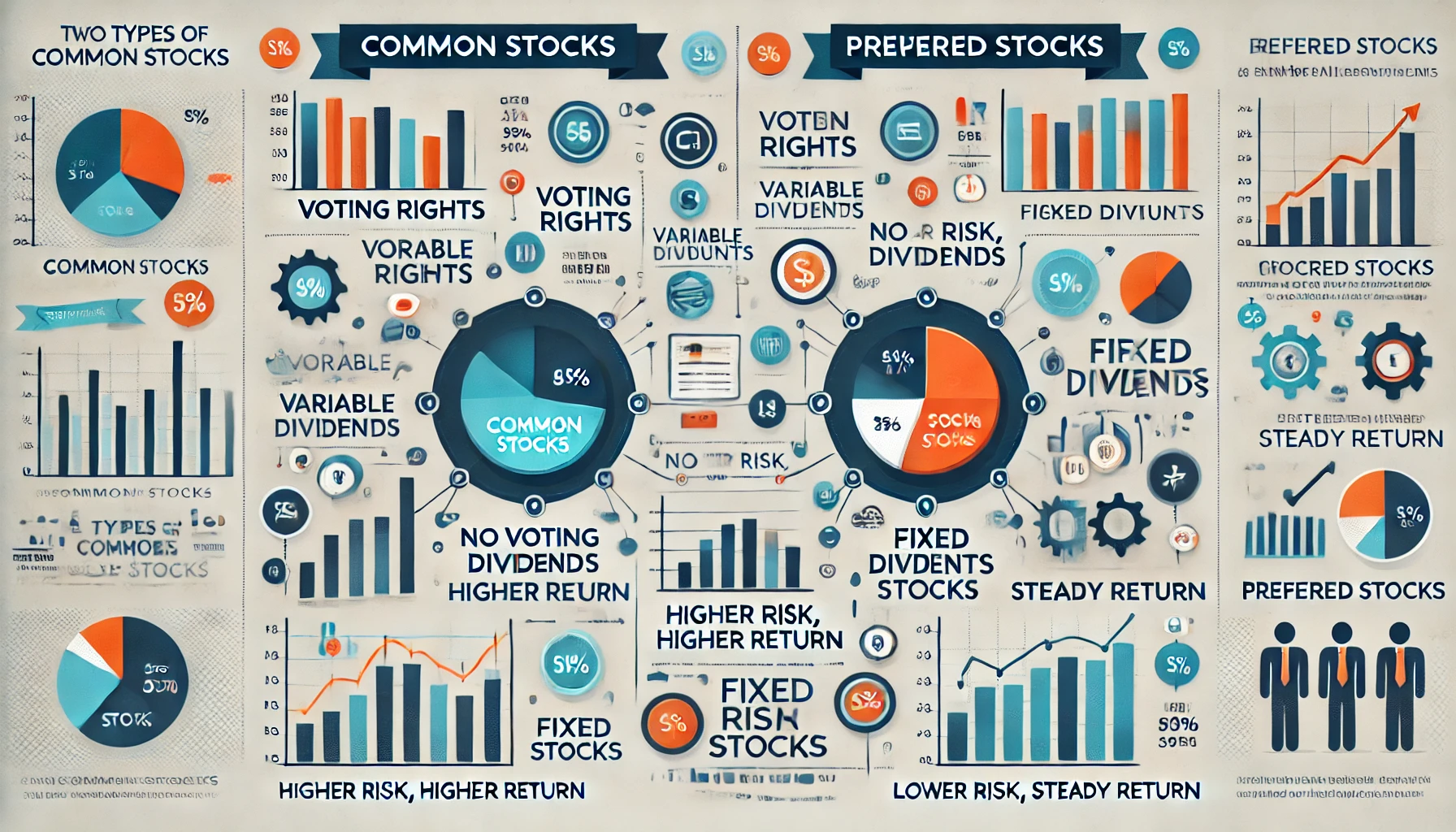Types of Stocks
When diving into the stock market, it’s essential to understand the different types of stocks you might encounter. The two primary categories are Common Stocks and Preferred Stocks. Each has unique characteristics, advantages, and potential drawbacks that can impact your investment strategy. Let’s explore these two types in detail to help you make informed investment decisions.
Common Stocks
Common stocks are what most people think of when they hear “stocks.” They represent ownership in a company and a claim on a part of the company’s profits, typically paid out as dividends. Here are some key points about common stocks:
- Voting Rights: Common stockholders usually have the right to vote on corporate policies and the board of directors. This means you have a say in significant company decisions.
- Dividends: Dividends are not guaranteed and can fluctuate based on the company’s profitability. Some companies may not pay dividends at all.
- Capital Gains: Investors buy common stocks primarily for the potential of capital gains. The stock price can appreciate, leading to a profit when you sell your shares.
- Risk: Common stocks are generally more volatile and riskier than preferred stocks. The value can go up and down significantly based on the company’s performance and market conditions.
- Last in Line: In the event of liquidation, common stockholders are the last to be paid. They only receive funds after creditors, bondholders, and preferred stockholders have been compensated.
Preferred Stocks
Preferred stocks are a bit different and come with their own set of features that might appeal to certain investors. Here’s what you need to know:
- Dividend Priority: Preferred stockholders receive dividends before common stockholders. These dividends are usually fixed and can be more predictable.
- No Voting Rights: Preferred stockholders typically do not have voting rights in the company. This trade-off comes with the benefit of higher claim on assets and earnings.
- Stability: Preferred stocks are generally less volatile than common stocks. They provide a steadier income stream, which can be appealing for conservative investors.
- Convertible: Some preferred stocks can be converted into a specified number of common shares, offering potential for capital appreciation if the common stock performs well.
- Cumulative Dividends: Many preferred stocks have cumulative dividends, meaning if a company skips a dividend payment, it still owes the missed payments to preferred shareholders before any dividends can be paid to common shareholders.
Comparing Common and Preferred Stocks
To better understand which type of stock might be suitable for your investment strategy, consider the following:
| Feature | Common Stocks | Preferred Stocks |
|---|---|---|
| Voting Rights | Yes | No |
| Dividend Payments | Variable, not guaranteed | Fixed, usually higher priority |
| Capital Gains | High potential, higher risk | Lower potential, lower risk |
| Liquidation Priority | Last | Before common stockholders |
| Volatility | Higher | Lower |
| Convertibility | No | Sometimes, can convert to common stocks |
Choosing the Right Type of Stock
Your choice between common and preferred stocks depends largely on your investment goals, risk tolerance, and need for income.
- Risk Tolerance: If you’re willing to take on more risk for the potential of higher returns, common stocks might be the better option. They can offer significant capital gains but come with higher volatility.
- Income Needs: If you’re looking for a more stable and predictable income stream, preferred stocks might be more suitable. The fixed dividends can provide a steady income, with less concern about market fluctuations.
- Growth vs. Stability: Common stocks are typically favored by those looking for growth and willing to ride out market ups and downs. Preferred stocks appeal more to investors seeking stability and fixed income.
Understanding the differences between common and preferred stocks is crucial for any investor. Common stocks offer potential for significant capital gains and voting rights but come with higher risk and volatility. In contrast, preferred stocks provide more stable and predictable income through fixed dividends, making them a safer investment choice. Investors must weigh their investment goals and risk tolerance when deciding between these two types of stocks. By doing so, they can build a diversified portfolio that balances growth and stability.
Tips for Investors
- Diversify: Don’t put all your money into one type of stock. A mix of common and preferred stocks can provide both growth and income.
- Research: Look into the company’s financial health and dividend history before investing in preferred stocks. For common stocks, consider the company’s growth potential and market position.
- Reinvest Dividends: If you don’t need the income immediately, reinvesting dividends can significantly boost your returns over time.
- Stay Informed: Keep up with market trends and company news. Changes in the market can affect the value of both common and preferred stocks.
- Consult a Financial Advisor: If you’re unsure about which type of stock to invest in, a financial advisor can help you develop a strategy tailored to your financial goals.
Conclusion
Both common and preferred stocks offer unique advantages and can play an important role in a well-rounded investment portfolio. Common stocks are ideal for those looking for growth and willing to accept more risk, while preferred stocks provide a stable income stream with less volatility. By understanding the differences and benefits of each, you can make informed decisions that align with your financial objectives. Always remember to diversify, stay informed, and consult with professionals to optimize your investment strategy.

